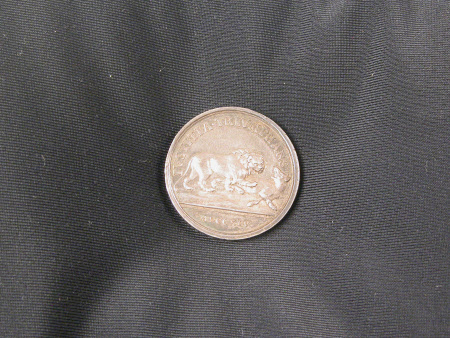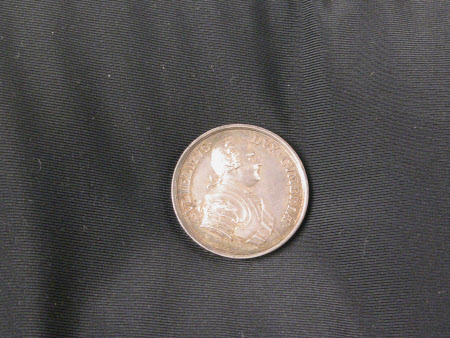The Rebels Repulsed
Thomas Pingo, the younger (1714-1776)
Category
Coins and medals
Date
1745
Materials
Silver
Measurements
329 mm (Diameter)
Place of origin
London
Order this imageCollection
Osterley Park and House, London
NT 773307
Summary
Silver, The Rebels Repulsed, by Thomas Pingo (1714-76), struck London, Great Britain, 1745. A silver medal by Thomas Pingo (1714-76), struck after Hanoverian forces, under the command of Prince William, Duke of Cumberland (1721-65), had retaken the strategic city and castle of Carlisle from the Jacobite rebel forces in late December 1745. The obverse has a profile portrait of the Duke facing right, bewigged and wearing armour and a sash. The legend reads ‘William, Duke of Cumberland’, whilst the artist’s signature is on the truncation. The reverse shows a lion overcoming a wolf, the legend translating as ‘Justice Triumphant’ and, in the exergue, the date, 1745.
Full description
The medal is one of the early works of Thomas Pingo Jr., the most prominent member of the Pingo dynasty, prolific makers of medals in 18th-century London. Thomas Pingo worked at the Royal Mint as a meal, seal and coin engraver. The Rebels Repulsed medal was struck after the city and castle of Carlisle had been retaken by the Hanoverian forces under the Duke of Cumberland in late December 1745, following the city’s brief occupation by the Jacobites led by Prince Charles Edward Stuart, Bonnie Prince Charlie (1720-88). The image of the lion on the reverse is intended to represent the British state overcoming rebellion in the allegorical form of a wolf. The legend on the reverse is a deliberate retort to Prince Charles who, on landing at Eriskay, had inscribed his standard with TANDEM TRIUMPHANS (“At last triumphant”). The same obverse was used for strikings of metal tickets for the Duke’s theatre, marked on the reverse BOX, GALLERY, etc. Jeremy Warren 2019
Provenance
Given to the National Trust in 1993 by George Child Villiers, 9th Earl of Jersey (1910-1998).
Marks and inscriptions
Obverse, legend: GVGLIELMVS. DVX. CVMBRIAE. Obverse, on truncation: T. PINGO F. Reverse, legend: IVSTITIA. TRIVMPHANS Reverse, exergue: MDCCXLV
Makers and roles
Thomas Pingo, the younger (1714-1776), medallist
References
Cochran-Patrick 1884: Robert William Cochran-Patrick, Medals of Scotland from the earliest period to the present time, Edinburgh 1884, p. 85, no. 6, pl. XVI, Fig. 1. Hawkins, Franks and Grueber 1885: Edward Hawkins, Augustus W. Franks and Herbert A. Grueber (eds.), Medallic Illustrations of the History of Great Britain and Ireland to the death of George II, 2 vols., London 1885, vol. II, p. 607, no. 265. Woolf 1988: Noel Woolf, The Medallic Record of the Jacobite Movement, London 1988, p. 98, no. 53:4. Eimer 1998: Christopher Eimer, The Pingo Family. Medal Making in 18th-century Britain, London 1998, p. 45, no. 2. Mitchiner 1988-2007: Michael Mitchiner, Jetons, Medalets and Tokens, 4 vols., London 1988-2007, vol. III (British Isles circa 1588 to 1830), 1998, p. 1720, no. 3.a (5024). Eimer 2010: Christopher Eimer, British Commemorative Medals and their Values, London 2010, p. 98, no. 600, Pl. 68.

